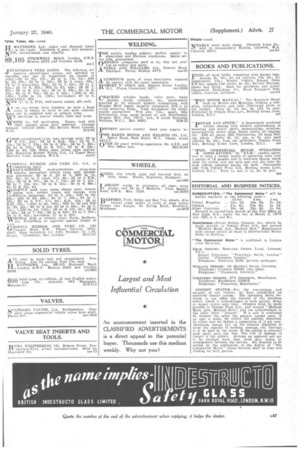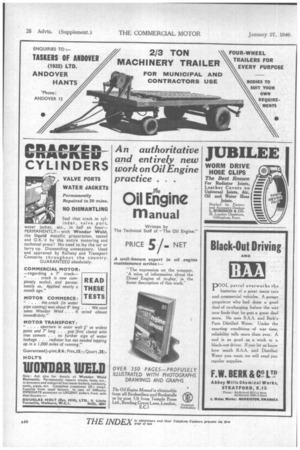PETROLEUM th(
Page 48

Page 49

Page 50

If you've noticed an error in this article please click here to report it so we can fix it.
Power that Comes
rom the Earth How Progress in, Oil Technology Has Assisted in the Development of Al! Forms of Transport Plant, Under the Control of One Man, that Purifies 500,000 Gallons of Spirit Per Day. Tests Employed to
Maintain Oil Standards
HOW the discovery of petroleum and the application of its derivatives have influenced every aspect of our lives, can be appreciated by considering but just one aspect of modern civilization—that of transport. There is no form of transport on land or sea, or in the air, which does not depend upon a derivative of petroleum for its effective operation.
It can be said, further, that the oil companies, by anticipating development in the design of engines, gearboxes, back axles and other chassis components, have materially assisted in the development of the high-efficiency units with which we are now familiar.
This applies, not only to lubricating oils, but to fuel as well, with particular reference to those burnt in units employing a high-compression ratio.
Opinions differ as to the true origin of the deposits from which petroleum is obtained, but one which is accepted in many quarters is that they have resulted from the decomposition of marine animal organisms, which lived and died in the shallow seas known to B14 have existed some hundreds of thousands of years ago.
Through the ages, vast areas have been engulfed as the result of disturbances caused by volcanic and other eructations and, thus, such living things, as existed, were buried and subsequently subjected to enormous pressures under conditions of heat.
It is known that mineral oil, in the crude state, of course, existed in ancient history, but it was not until the year 1854 that any direct efforts were made to search for it. At that time the necessary geological knowledge was scanty, and the sinking of wells was, in consequence, a fairly haphazard and certainly a costly procedure. In
confirmation of this it is to be noted that, between 1859 and 1869, 5,560 wells were sunk, of which no fewer than 4,374 proved to be worthless.
Whilst there is still an element of speculation, oil-bearing areas can now be located with a fair degree of precision by the aid of instruments, whilst the one-time laborious drilling methods have given place to systems which are efficient and expeditious.
, In the early days, the wells ranged from 50 ft. to 100 ft. in depth, whereas Modern borings may reach thousands of 'feet, the drills having to pass through
such obstructions as limestone beds, which may, in themselves, be 1,000 ft. or so in thickness.
Following the production of the crude petroleum, comes the important process of refining and separation into the many useful components of which it is comprised. It is a long list, but amongst the commodities are motor spirit (petrol), kerosene or lamp oil, gas oil, wax, fuel oil and pitch for road making.
The procedure adopted varies as between the refining methods of the big oil companies, but, so far as lubricating oil is concerned, the main purpose, in all cases, is to remove the undesirable contituents. Considerable progress has, in recent years, been-made in this direction, with the result that lubricating oils, in general, 'appear to lack body. The fact is, of course, that most of the unstable hydrocarbons—some of which are actually of a tarry nature—having been removed, the oils look clearer, pour much easier and possess consider' ably enhanced lubricating properties.
In order to maintain definite standards as between one grade and another of any one make o oil, the oil chemists adopt a recognized series of physical tests which are usually referred to as specific gravity; flash point; fire . point; cold, coke, oxidation and acid.
None of ,these, however indicates the quality of the lubricant, but the series of tests serves to give an indication of the suitability of an oil for a specific duty.
The recommendations which are given by the oil companies, as to the correct grade of oil to use in a particular engine, gearbox or back axle, have been largely developed as the result of
experience in actual service. Nevertheless, extensive experimental work is, at all times, being conducted, as the oil industry cannot afford to lag behind progress in the engineering world.
As new lubricants or processes are devised, so are tests carried out on special machines, so designed as to subject the finished products to abnormal. conditions of usage. In this way, the oil companies are able to putforward a new grade, or series of grades, in the full knowledge that the oils will meet a definite operating condition without breaking down.
By such means, the oil corapanie are, in no small measure, . assisting designers to reach the peak of efficiency in existing types of prime-mover.
As previously mentioned, petrol and fuel oil form two further products obtained from the distillation of crude petroleum, a typical instance, of the proportions of these commodities to be found in the crude being crude naphtha (from which motor spirit is obtained), 40 per cent.; fuel oil, 12 per cent.; lubricating oil, 17 per cent. These percent ages vary considerably as between one crude and another, as, in some instances, a crude may be rich in motor spirit, whilst another may be superior in respect of lubricating-oil content.
Nevertheless, it is a truism to say that good oil is never found, although it is equally true to say that no Manufacturing process can put into the crude, qualities not miginally possessed by it.
The crudes from certain fields have a poor lubricating oil content, and whilst the oils produced may be used in certain spheres, they can never be sold as first-quality motor oils.
Such variations in the composition of crude oils are obviously concerned with the geological structure of the areas coneerned, whilst there are also the questions of heat and pressure, and the age and origin of the deposits.
In explaining the difference which exists between certain American and Russian oils, one authority is of the opfilion that Russian oils, which are rich in naphthenes and paraffins, were formed under conditions of high temperature, whilst those from America, which contain little naphthenes, suggest a long period of storage under low-temperature conditions.
Regarding motor spirit, this product, as distilled, is washed by being brought into contact with purifying chemicals, • :me of the most up-to-date plants in existence being capable of purifying 500,000 gallons of spirit in a day, the plant being in the hands of only one man. Fuel oil, as distilled, represents
a finished product, as it requires no further treatment.
By way of concluding these necessarily brief remarks on petroleum, reference should be made to the all-important role played by all forms of transport. Pipe-lines are used extensively, the run, in some cases, being hundreds of miles in length.
Year in and year out ocean-going tankers plough their way through tempestuous seas, their decks, more often than not, fully awash.
Road transport is held responsible for carrying out bulk distribution to consumers, the tank vehicles used for the purpose ranking amongst the most striking machines to be seen on the roads. We are indebted to the Vacuum Oil Co., Ltd., and Shell-Mex and P.B., Ltd., for the accompanying pictures.




















































































